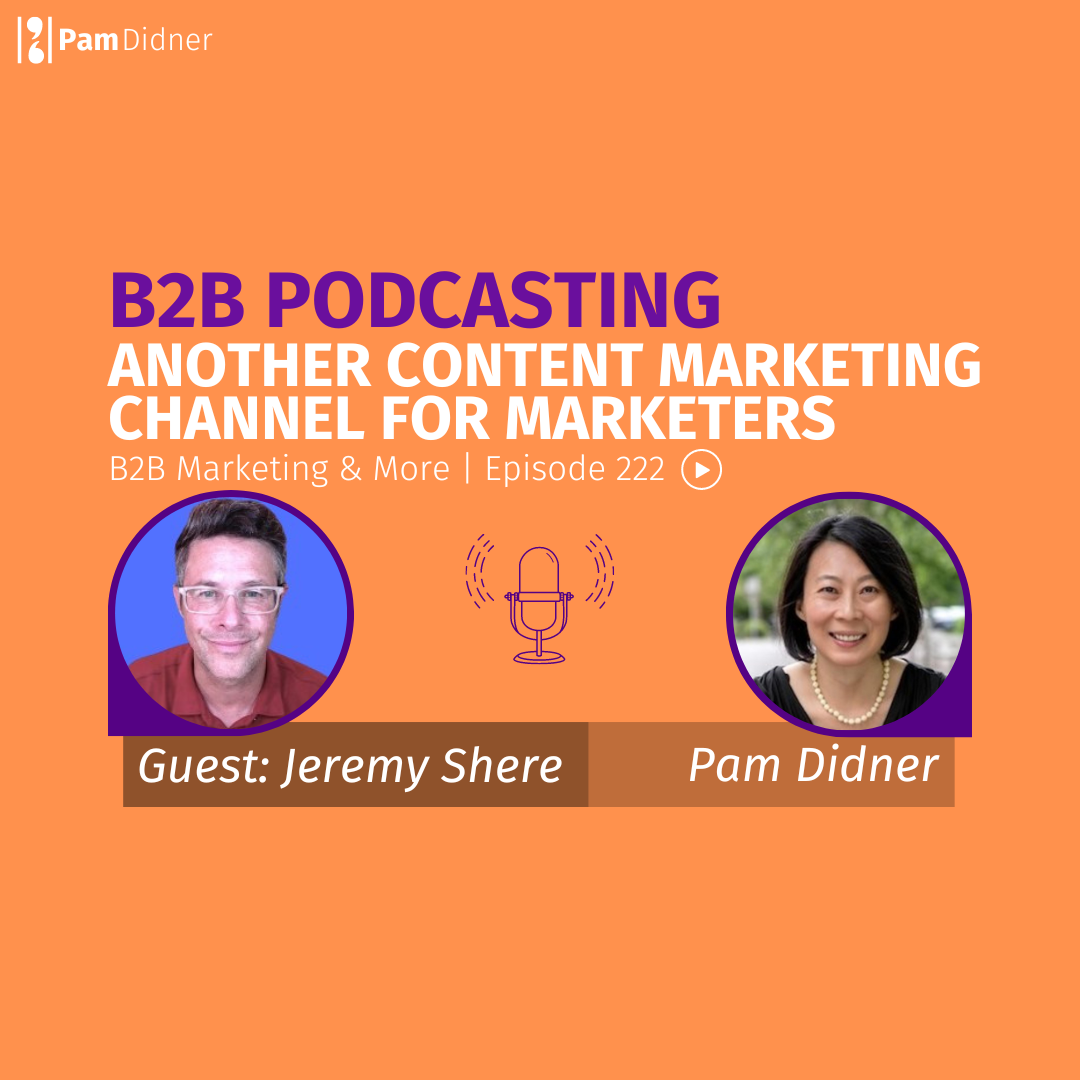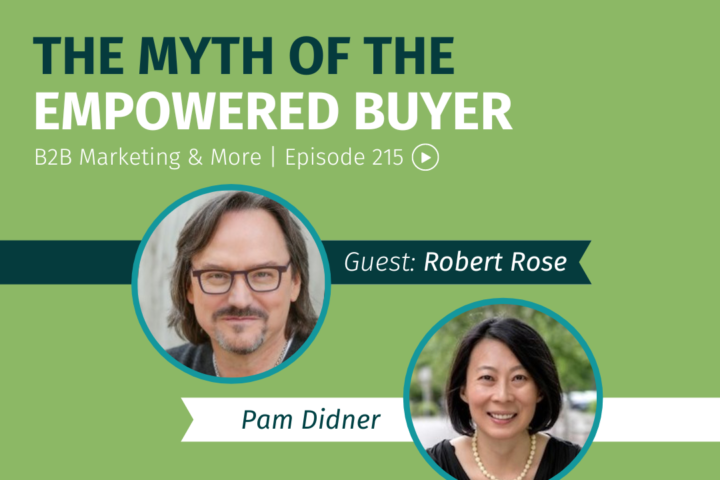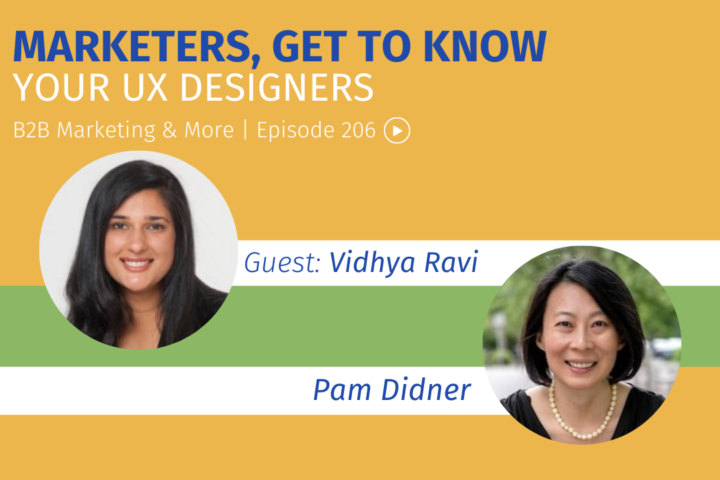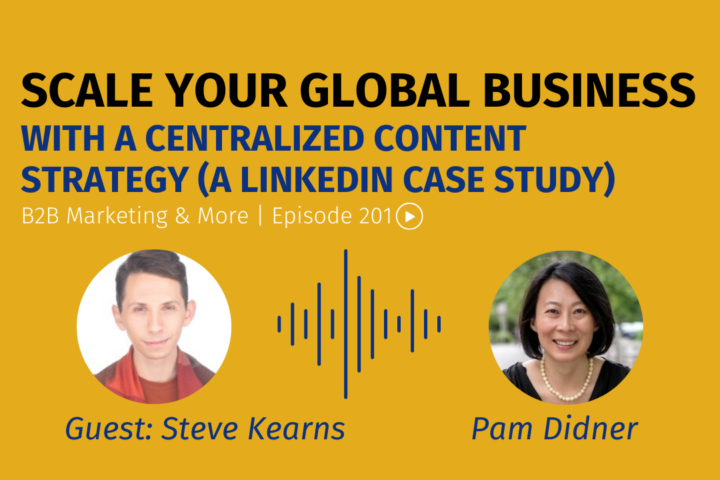
Welcome to another B2B Marketing and More episode. My guest is Jeremy Shere. He is the founder and CEO of Connversa Podcasting and the host of the B2B Content Show.
Jeremy is an expert in this field and has been doing podcasting for a long time. Today we talk about the do’s and don’ts of B2B podcasting and how to showcase value add if you want to use a podcast as a content marketing channel.
In this episode:
- What is the value of B2B podcasting for B2B companies?
- What should B2B marketers think about podcasting as a channel?
- How to measure the success of a B2B podcast with examples?
- What are the costs of podcast production?
- How to pick the right podcast producer?
- How to outsource podcast production?
- How to make a podcast stand out from the crowd?
Quotes from the episode:
“You know, to get the quality that I think people have come to expect and that you should want, if you’re gonna put stuff out there with your voice or your name on it – the quality matters a lot.”
“The central value of podcasting is that, by its nature, it involves having real, unscripted one-on-one conversations with people that you want to be talking to.”
—————
Enjoy the podcast? Subscribe to the show on your favorite podcast platform, leave a 5-star review, and subscribe to Apple Podcasts.
If you prefer watching a video, I also have a YouTube Channel; check it out and subscribe.
If you want to chat, contact me on any social media channels or email me at hello@pamdidner.com. You can also join my Facebook community: Build Your Marketing Skills to Get Ahead.
To expand your knowledge about B2B podcasting, check out some of my previous podcast episodes, blog posts, and video.
Podcast episodes
Top Guidelines for Starting, Sustaining and Growing a Podcast
What is Account-Based Podcasting and Why Your Company Needs It
Thinking of Starting a B2B podcast? Here’s What You Need to Know
Blog post
Six Ways to Start Subject Matter Experts Thinking Like Content Marketers
How to Create Scalable Global Content Marketing Strategy: A Guide for B2B Marketers (+ Templates)
Video
Building a Marketing Strategy and Aligning it With Your Business Goals
TRANSCRIPT
Welcome to another episode, B2B Marketing and More, with Pam Didner from Raleigh, North Carolina. So big, big hello to everyone. And this time, we want to talk about something very special: podcasting. Well, I’m doing podcasting right now. Still, I really want to talk to an expert that has been in this field for a long period doing podcasting, and then come talk to us in terms of what dos and don’ts and also how you can showcase value add if you want to use podcasts as a content marketing channel.
So today, we have Jeremy Shere. He’s a founder and the CEO of Connversa, the B2B podcasting agency on top of it. He’s also the host of the B2B content show. Yay. Thank you for coming to my show.
Jeremy Shere: Well, Pam, thank you so much for having me. It’s so awesome to be here.
Pam Didner: I know you are the expert. So I have many, many questions I would like to ask you. Okay. So the thing about podcasting is it has become so popular nowadays that almost every celebrity has a podcast show. What is the value add for B2B companies, and what should the B2B marketer think about podcasting as a channel?
Jeremy Shere: First, of course, you’re exactly right. Podcasting has generally blown up over the last 6, 7, 8 years, you know? And with tens of millions of people just in the United States alone–and around the world, many more than that–regular podcast listeners, you know, it’s just become a part of a daily part of people’s lives.
And for the general person, you know, why are people listening to podcasts for entertainment to learn things? But you asked a good question, like, “oh, okay. That’s fine. But what does this have to do with B2B marketing?” There are a lot of ways to answer that question. Podcasting alongside your other marketing channels can add some dynamic and unique elements that you’re not necessarily already getting from, say, a blog, a webinar series, or the videos you’re doing; you can break that down in a couple of different ways.
The central value of podcasting is that, by its nature, it involves having real, unscripted one-on-one conversations with people that you want to be talking to, just like we’re doing right now, right? And so, if you’re in a B2B market, you start a podcast. It’s all about who you want to talk to on the podcast. When you start a podcast and invite guests, you have 20 minutes, 30 minutes, 40 minutes, or maybe an hour to have a real conversation with them. That’s not a sales call. It’s not a marketing event but a real human interaction. And if you’re strategic about who you invite on, then that’s really valuable time with that person. So let’s say you target your best prospects from among your audience.
Pam Didner: Invite them on. Yeah. Or your customers have them talk about their best practices. Yep.
Jeremy Shere: Yeah. Your existing customers, prospects, and thought leaders in your industry. And so you bring them onto your show, and you’re doing a few things there. First, you’re getting exclusive time with them to have an in-depth conversation about something they’re passionate about. It’s a great way to develop relationships with the people you’re talking to.
You also learn a lot about them. What they care about, how they think, and what matters to them, both as people and in business. So that gives you valuable insight into going forward, you know, how to communicate with them.
Also, you’re creating content with them. So, just by the nature of having them on your show and then producing the episode, you’re already working with them, collaborating with them and demonstrating what you can do and what it’s like to interact with you. And as long as you follow through and do what you say you’re gonna do, you make it a great experience. You do a really good interview, and it’s fun, and it’s invigorating. Then you produce the show at the highest level, and you put it out there, and you promote it–and so you’re promoting them and their thinking and their thoughts and their expertise–you’ve added a lot of value.
And you’ve gotten a lot of value. So it’s this great exchange of value without explicitly selling or marketing. It’s just you’re building a strong relationship.
Pam Didner: I love that. One of my guests, Bernie Borges. He was using the term account-based podcasting for his company’s podcast. They always have a list of accounts and the prospects they would like to reach out to and possibly build a relationship with. And they use the podcast as a channel to reach out to a prospect and invite them to be on the show. And it was a great way for them to build a relationship. So it’s taking that account-based marketing concept down to the podcast channel.
Jeremy Shere: Yeah, no, that, that’s a great example.
Pam Didner: So Jeremy, I know that, uh, you manage podcast productions for many B2B companies and clients. So how do they measure success? Is it just the number of downloads, and that is it? I know subscribers, anything else specific?
Jeremy Shere: It depends on what your goals are for the podcast and sort of what your expectations are.
Pam Didner: Well, give us some examples.
Jeremy Shere: Well, let’s start with what you already said. The standard way to measure the success of a podcast is by downloads, right? So what we’re talking about is, for a given episode, how many people are engaging with it? How many people are listening, right? And you get that data, and you, and if you’re producing a podcast, then you have access to that data. And that’s all about your, uh, your audience, right? How is your audience growing? How large of an audience are you? Are you managing to build? That metric is very different if you’re a B2B marketer and podcasting. If you are podcasting, just reach as many listeners as possible if your show is mainly for entertainment.
And it’s important to keep in mind that you’re doing a very niche podcast. If you’re doing a B2B podcast right, you are aiming it at a particular audience. One of our clients is a SaaS company in the supply chain space. And so their podcast is aimed at supply chain professionals.
Pam Didner: Yep. Procurement managers, supply chain professionals.
Jeremy Shere: Yes. And I don’t know how many of those people there are out there in the world. Right. But it’s a very particular group of people, like a very niche audience. And so you’re trying to capture the biggest percentage of that audience, you can, but in raw numbers, it’s not going to be anything like the most popular podcast in the world that gets millions of listeners. Right?
Pam Didner: So you set up expectations, obviously, with your clients; but still, how do they major their success?
Jeremy Shere: It helps to understand your audience and the potential audience. So you might be getting 150 regular listeners per episode, let’s say. And in raw numbers, that might not seem like a lot. It all depends on the context. That means every single time you put in, put out an episode getting 150 people, the exact people who are your audience, right? that you’re providing services for, who are tuning in to hear what you have to say and what your guests have to say. Right? So there’s a different way of thinking about it. So, in any case, that’s just one way of measuring.
Another way of measuring the value is the content that you’re generating from the podcast. I was on a call with a client just the other day. And I asked her, you know, “how, how is the podcast going? What can we improve?” And I said, “well, why don’t we look at the, you know, the numbers, the download numbers.” And she said: “you know what? We can do that, but I’ll be honest: I don’t look at those numbers so much. I have a general sense of them, but that’s not really how we value the podcast. It’s all about the content that it generates.”
So for every episode, they get the audio episode. We record a video for them. So they also got the video. I take that video and repurpose it as promotional content, and then they turn every episode into at least one blog post and social media content. So for this particular client, the main value lies in the fact that it’s a content generation engine that helps them produce content much more efficiently than before.
Pam Didner: Can you also share with us, given that you work with mainly B2B companies and many B2B marketers will be curious to find out how much it costs to produce an episode? And, if they have to set up a budget, what will it look like? And also, how much it costs to produce an episode?
Jeremy Shere: Yeah. There’s a pretty wide range, and it, of course, depends on what kind of podcast you’re doing and what production you are getting into. So for us, I can tell you what our pricing range is. At the simplest end, where we’re just producing a pretty basic audio podcast, interview style. We’re focusing primarily on the post-production, the client records, and then they send us the files, and we edit them, produce them, make them sound awesome, and package them all together. Put in the music, the intro and the outro, and upload it to the hosting platform. That’s gonna be somewhere in the range of probably $700, $800 per episode, per episode. And you know, typically, people will buy a package of episodes that might have some discount built in.
If you’re getting a little more complicated and looking for preproduction services–that might include helping you find guests, book guests and questions, and doing everything that needs to happen to prepare you to record the interview. And you, you might want like an engineer, just like you have Scott behind the scenes. If you need, you know, uh, an engineer just to make sure everything sounds good, looks good to troubleshoot if any problems come up. So then that’s a higher level of service, and yeah. Then you’re talking anywhere from about, um, you know, $1,200, $1,500 an episode.
And then, another tier reproduces each episode to create other kinds of content. So producing a full-length video episode, promo videos of blog posts, all that stuff. Then you’re looking at anywhere from maybe $1,800 to over $2,000 an episode, somewhere in that range. That’s kind of where we are at the moment. And if, if people go online, they’ll probably find some that are a bit less, some that are, that might be. More depending. And, you know, there might be companies offering services that we’re not doing right now.
So people who are watching or are listening to this might be thinking, “well, okay, what if we just found a freelancer on Fiverr who could just, you know, do some really basic editing and, and stuff like that? And, you know, I’ll say you can do that. You can find a much cheaper way to do all this.
Pam Didner: Can I interrupt and provide feedback on that? Yeah, sure. Jeremy, I agree that all B2B marketers can do that. And that if budget is a huge concern, they have no choice but to do that; however, I have done that because I produce podcasts myself, and I also produce YouTube videos myself in the past.
So I started to go to Fiverr. I went to UpWork to find the production systems and the editor. And I’m not saying that you cannot find the right way. I agree with Jeremy on that because I have done it in the past. I end up not doing that. If you are a B2B company and are happy to be a marketer representing your brand, I hate saying this. I strongly suggest not doing that. Unless budget is a huge, huge issue. Also, I would hire someone with a high level of experience.
It’s quality over quantity, from my perspective. So, but that’s just my very strong opinion. I’m passionate about that, Jeremy; sorry to interrupt you again, but I have done that. So, it was not always what I was looking for, and I hate saying it.
Jeremy Shere: Yeah. Well, look, I’m a little biased, but I think. The reason and, you know, tell me if this was your experience, but what you run into when you, you know, might hire somebody for like 20 bucks an hour to edit your podcast is you usually get what you pay for in terms of the quality.
Pam Didner: Yeah. I 100% agree with that. Yeah.
Jeremy Shere: And there are different schools of thought on this. You know, one school of thought just says, record some stuff and put it up there. The audio quality is not the most important thing. It’s more important to just record and get stuff out there at volume. And I disagree with that just because maybe that might have been true at one time. Still, I think these days there are so many more podcasts out there that if, if you’re serious about it and that you actually, you want to grow an audience and you want to attract people, and you want to get the best guests, you’re kind of competing against the best podcast out there. And people have come to expect a certain level of quality.
Pam Didner: I do agree with that, too.
Jeremy Shere: And to keep producing episodes week after week, month after month at that same high level, it takes a team of people. Yep. It can get overwhelming if you’re trying to do it yourself. Or if you just have a freelancer who may or may not be that good at it or might disappear at some point. You know, to get the quality that I think people have come to expect and that you should want, you know, if you’re gonna put stuff out there with your voice in it, or your name on it. The quality matters a lot.
Pam Didner: Hey, this is wonderful. Jeremy, it’s wonderful to have you with me at my show and share your wisdom, knowledge, and insight in doing the podcasting and the value provided to the B2B marketers. So thank you for coming to my show.
Jeremy Shere: Oh, you’re so welcome. It was a real pleasure. I had a great time.
Pam Didner: Take care, everyone. Bye.



